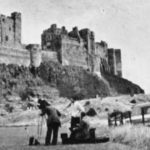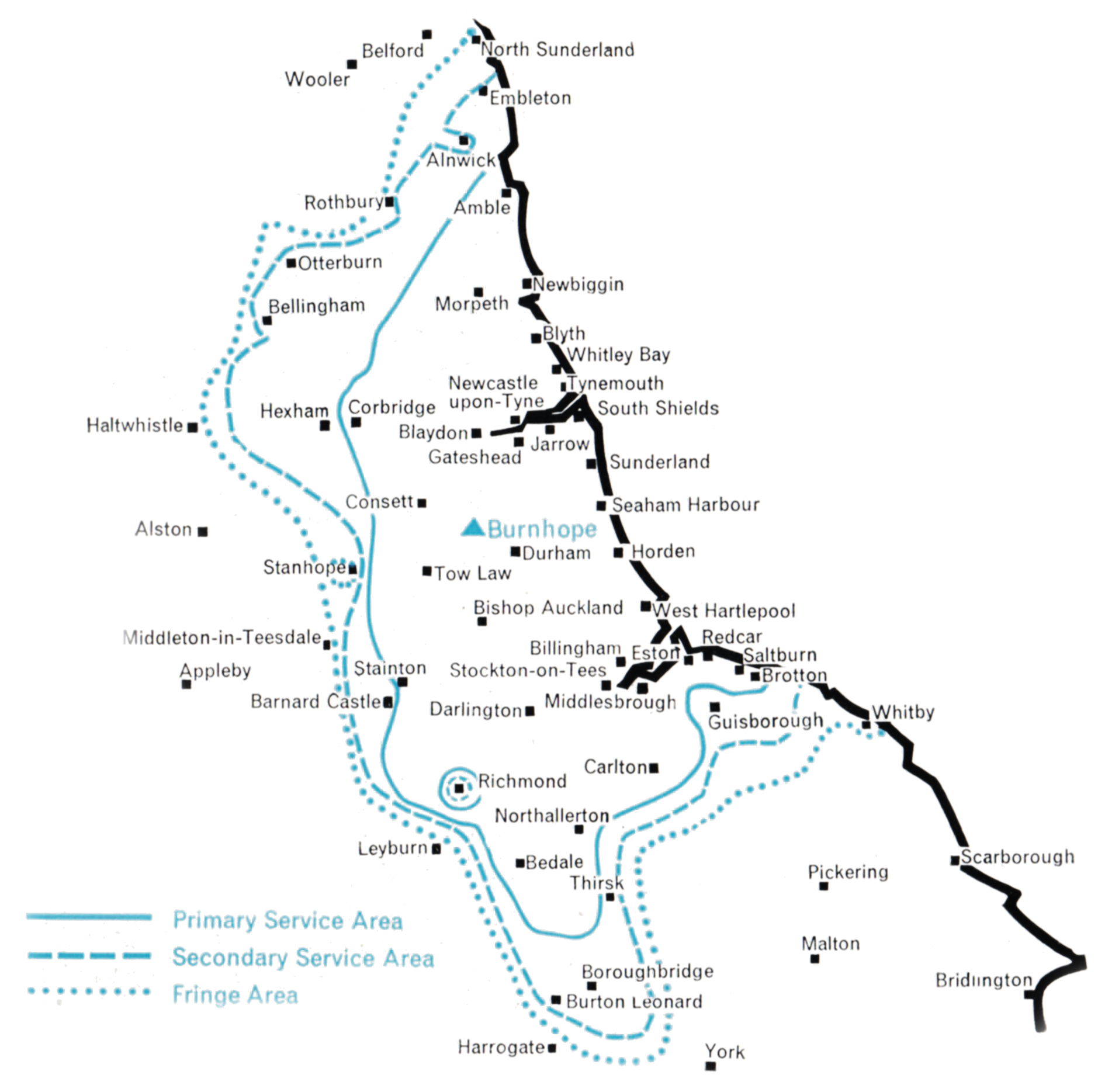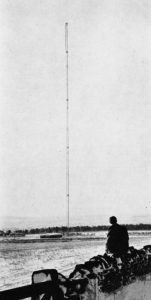North-East England

Tyne Tees Television is the company which, under agreement with the Independent Television Authority, provides the television programmes in North-East England during the whole week.
The Television Centre, City Road, Newcastle upon Tyne, 1.
NEWCASTLE 610181
1 Great Cumberland Place, London W.1.
AMBassador 3464
ITA Channel Vision Sound Opening Date Population ITA Homes
Transmitter Frequency Frequency 000's 000's
Mc/s Mc/s
Burnhope 8 189.75675 186.27 15th Jan 1959 2,720 649
Directors
Sir Richard A Pease, Bart, DL, JP; CC Darling, MA; Colonel EG Angus, CBE, MC, TD, DL, JP; George Black; Alfred Black; Sydney Box; Laurence Cadbury; Prof EJR Eaglesham, MA, B.Ed, LL.B; EG Fairburn; DA Pease, ACA; The Rt Hon Viscount Ridley, CBE, DCL, DL, JP; Sir Harold G Howitt, GBE, DSO, MC, DCL, LL.D, JP; A Jelly (Managing Director).
Officers
Programme Directors: George and Alfred Black; Programme Controller: W Lyon Shaw; Sales Director: Peter S Paine, DFC; Chief Engineer: Dennis G Packham; Business Manager: JP Graham, FCIS; Company Secretary: GS Wood, MA, ACIS; Accountant: B Hanks, B.Com, ACA.
Religious Advisers
The Reverend Charles Smith, BA (C of E); The Reverend Father Thomas Towers, MA (Roman Catholic); and The Reverend WV Harper (Free Church).
Schools Liaison Officer
B Shallcross, BA.
Staff
Total number of staff is 450, including resident artistes and musicians.
Visits to Studios
Tickets in limited numbers are available for both lunchtime and evening shows. Applications to the Ticket Unit, Tyne Tees Television Ltd., City Road, Newcastle upon Tyne. The minimum age is sixteen.
Enquiries
Enquiries, of whatever kind, should be addressed in the first instance to the Information Office at City Road, Newcastle upon Tyne.
Programme Journal
The Viewer publishes full details of the available programmes.
Educational
Tyne Tees arranged a major educational conference in 1962 lasting a full day, and plans further conferences in 1963.
Studios
THE TELEVISION CENTRE, City Road, Newcastle upon Tyne, 1 (Newcastle 610181). There are three separate buildings linked by a corridor at first-floor level. Block A: Studios, studio facilities and production offices, technical areas and engineering department offices, medical services and restaurant. Studio 1, 4,500 sq. ft.; Studio 2, 2,500 sq. ft.; Studio 3, 900 sq. ft.; and Studio 4, a small presentation studio. Block B: Scenic Department comprising art studios, scenic workshops, scene storage and property store. Block C: Administration services, sales department, schools liaison, personnel office, news department, features department, press and public relations and publicity office, underground garage. The floor area of the Television Centre is approx. 100,000 sq. ft.
Technical Facilities
The production studios, nos. 1, 2, and 3, are equipped with a total of ten 4½-in. Image Orthicon Cameras, six of them being of the latest type using the “hands-off” control technique. The sound equipment in these studios consists of a 30-channel fully transistorized mixer, and two valve mixers of 16 and 14 channels.
The Outside Broadcast Unit uses six 4½-in. Image Orthicon Cameras mounted in the two Mobile Units, its vision link facilities being three 7,000 Mc/s 1 watt equipments.
The station’s Central Technical Facilities comprise the master control and presentation suite, soon to be replaced by a completely new installation, and a recently rebuilt telecine and videotape area. This is equipped with three videotape recorders, four vidicon telecines, unmarried 16-mm. sound facilities, and three vidicon caption scanners.
Outside Broadcasts
One mobile unit, with four cameras, complete with videotape, power and micro-wave link equipment. Can record also on European and American line standards.
Research and Sales
The Sales Department (Sales Director, Peter Paine) and the Research Department are in the London offices at 1 Great Cumberland Place, London W.1.
Programmes
Tyne Tees productions include: Light Entertainment: The One O’Clock Show, four times a week; The Ivor Emmanuel Show, weekly series; Young at Heart, weekly series for teenagers; Happy-Go-Lucky, weekly series for the little ones. Music: Your Kind of Music, including orchestras, concert artistes and the ballet, monthly series. Instructional: Stories of the Ballet, 12-part series; Your Heritage, continuing series; Three Rivers, stories of Tyne, Tees, Wear. News: North East News, twice daily. General Features: North-East Roundabout, every evening Monday to Friday. Special Features: Spotlight on Coal, River Pollution, Delinquency, etc., and other topical subjects; Robens meets the Press, on the coal industry. Politics: North-East in Parliament, periodical feature; the Prime Minister, the Leader of the Opposition, and the Leader of the Liberal Party have all broadcast from Tyne Tees studios. Religion: regular Sunday morning services from local churches of all principal denominations; epilogues every night – music or poetry readings by a member of the staff, or bedtime talks by a panel of local clergymen of all principal denominations; periodically, important senior churchmen are invited to make a special broadcast; and there are special religious features such as The Path to the Priesthood from Ushaw College and Nuptial High Mass. Outside Broadcasts: functions and occasions of special interest to North-East viewers, e.g. “Blaydon Races” Centenary, Durham Miners’ Gala, etc. – as well as the usual sporting activities.
Local News and Weather
The permanent news staff comprises the news editor, three reporters/interviewers, together with one secretary/script typist, and three copy takers. More than 100 free-lance and newspaper staff correspondents cover the area, filing copy daily. There are two staff camera units, one silent and one with sound, plus four free-lance silent/sound camera units. The Encyclopaedia Britannica Award, News Cameraman of the Year 1962, was awarded to staff cameraman Jim Hodkinson of The Tyne Tees News Department for his dramatic film of a Newcastle factory fire.



